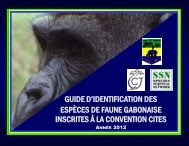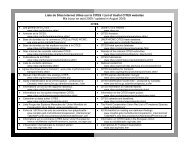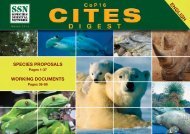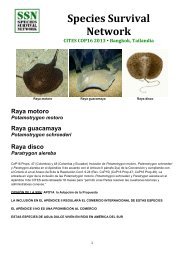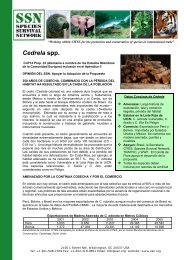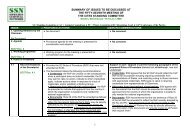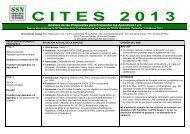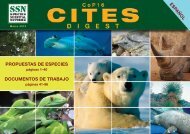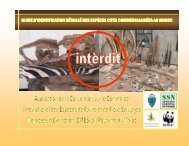SSN's Comments on South Africa's Regulations on Threatened and ...
SSN's Comments on South Africa's Regulations on Threatened and ...
SSN's Comments on South Africa's Regulations on Threatened and ...
Create successful ePaper yourself
Turn your PDF publications into a flip-book with our unique Google optimized e-Paper software.
inc<strong>on</strong>sistent with the definiti<strong>on</strong> of the same term in Resoluti<strong>on</strong> C<strong>on</strong>f. 10.16 (Rev.) of the C<strong>on</strong>venti<strong>on</strong> <strong>on</strong><br />
Internati<strong>on</strong>al Trade in Endangered Species of Wild Fauna <strong>and</strong> Flora (CITES).[1] C<strong>on</strong>sidering that<br />
specimens covered by these draft regulati<strong>on</strong>s are likely to be CITES-listed species (such as li<strong>on</strong>s <strong>and</strong><br />
leopards), <strong>and</strong> that CITES is implemented in <strong>South</strong> Africa in part through these regulati<strong>on</strong>s, it is<br />
imperative that the definiti<strong>on</strong> is identical to the CITES definiti<strong>on</strong> of “bred in captivity”. The draft<br />
definiti<strong>on</strong> is also unclear because, firstly, the term ‘bred’ as used in the definiti<strong>on</strong> seems to imply the<br />
birth of the animal rather than the breeding process; the former is inc<strong>on</strong>sistent with the CITES<br />
definiti<strong>on</strong>. Sec<strong>on</strong>dly, combining this definiti<strong>on</strong> with the related draft definiti<strong>on</strong>s of “c<strong>on</strong>trolled<br />
envir<strong>on</strong>ment” <strong>and</strong> “extensive wildlife system” leaves open the possibility of animals being bred in a<br />
captive setting <strong>on</strong> an extensive wildlife system, where they may also be hunted. As noted below, the<br />
draft definiti<strong>on</strong>s of “c<strong>on</strong>trolled envir<strong>on</strong>ment” <strong>and</strong> “extensive wildlife system” significantly overlap.<br />
Both terms allow for food, water, health care <strong>and</strong> fences. Yet, animals bred <strong>and</strong> born in captivity in an<br />
“extensive wildlife system” would not be c<strong>on</strong>sidered “captive bred” under these definiti<strong>on</strong>s. Nor would<br />
such systems be c<strong>on</strong>sidered to be “captive breeding operati<strong>on</strong>s” under the draft definiti<strong>on</strong> of that term.<br />
Definiti<strong>on</strong>: Captive-breeding operati<strong>on</strong><br />
This definiti<strong>on</strong> applies <strong>on</strong>ly to animals bred in a c<strong>on</strong>trolled envir<strong>on</strong>ment. It does not apply to animals<br />
bred in an extensive wildlife system. If this definiti<strong>on</strong> is to remain as drafted, the terms “c<strong>on</strong>trolled<br />
envir<strong>on</strong>ment” <strong>and</strong> “extensive wildlife system” need to be further distinguished from <strong>on</strong>e another.<br />
Otherwise, this definiti<strong>on</strong> will open up a loophole for the c<strong>on</strong>tinuati<strong>on</strong> of breeding animals for canned<br />
hunting in extensive wildlife systems.<br />
Definiti<strong>on</strong>: C<strong>on</strong>trolled envir<strong>on</strong>ment<br />
This definiti<strong>on</strong> is not c<strong>on</strong>sistent with the definiti<strong>on</strong> of the same term in CITES Resoluti<strong>on</strong> C<strong>on</strong>f. 10.16<br />
(Rev.).[2] C<strong>on</strong>sidering that specimens covered by these draft regulati<strong>on</strong>s are likely to be CITES-listed<br />
species (such as li<strong>on</strong>s), <strong>and</strong> that CITES is implemented in <strong>South</strong> Africa in part through these<br />
regulati<strong>on</strong>s, it is imperative that the definiti<strong>on</strong> is identical to the CITES definiti<strong>on</strong> of “bred in<br />
captivity”. As noted above, the draft definiti<strong>on</strong>s of the key terms “c<strong>on</strong>trolled envir<strong>on</strong>ment” <strong>and</strong><br />
“extensive wildlife system” significantly overlap <strong>and</strong> are indistinguishable. Both terms allow for food,<br />
water health care <strong>and</strong> fences. These are key definiti<strong>on</strong>s because wildlife can be c<strong>on</strong>sidered “bred in<br />
captivity” or “captive bred” <strong>on</strong>ly when produced in a “c<strong>on</strong>trolled envir<strong>on</strong>ment”, not an “extensive<br />
wildlife system”.<br />
Definiti<strong>on</strong>: Culling<br />
Definiti<strong>on</strong>s (a) <strong>and</strong> (b) of “culling” allows for a “pers<strong>on</strong> designated by” an official of the management<br />
authority of a protected area to kill animals. We recommend clarificati<strong>on</strong> that such a pers<strong>on</strong> should be a<br />
professi<strong>on</strong>al (not an amateur) marksman with dem<strong>on</strong>strated experience <strong>and</strong> skill in killing the species<br />
in questi<strong>on</strong>. Definiti<strong>on</strong> (b) states that animals that have escaped from a protected area may be killed “as<br />
a matter of last resort”. We recommend this term be clarified by adding the following words: “… as a<br />
matter of last resort after all other opti<strong>on</strong>s have been carefully evaluated.” We also recommend that this<br />
language be included in definiti<strong>on</strong> (a).<br />
Definiti<strong>on</strong>: Damage causing animal<br />
The draft definiti<strong>on</strong> does not reflect the fact that assessment of damage is largely subjective; threshold<br />
estimates of damage should be required before an animal is c<strong>on</strong>sidered to be damage-causing <strong>and</strong><br />
becomes a target. In additi<strong>on</strong>, it must be recognized that while individual animals may cause damage,<br />
this does not mean that the species as a whole should be c<strong>on</strong>sidered ‘damage causing’. We recommend<br />
3



